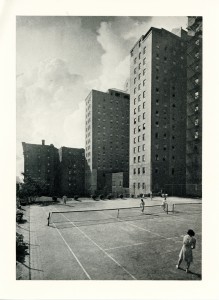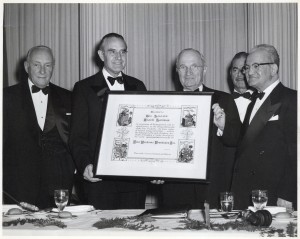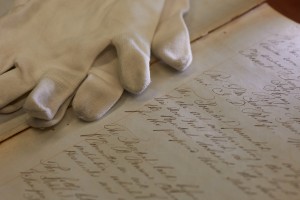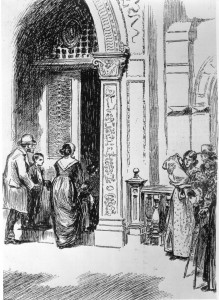Apr 7, 2016
In the October 1925 meeting of The Mount Sinai Hospital Board of Trustees minutes, the Trustees discuss a request from the House Staff for the Hospital to build a golf cage on the roof of the staff housing. The Trustees agreed but wanted the Medical Board to approve it and to decide “whether it might not be detrimental to the care of the patients to furnish this additional amusement to the house staff.” The project was eventually approved by the Medical Board, but it is unclear if the golf cage was ever built.

The Mount Sinai tennis courts, at Fifth Avenue and 99th Street.
This request was part of a trend for the active House Staff. In 1923, the Board had approved funds to build a tennis court for the Mount Sinai medical staff and School of Nursing students. It was erected on the corner of Fifth Avenue and 99th Street. Sadly, it was closed in 1948 to make way for the Klingenstein Pavilion.
In a 1988 interview, Gus Burton, a Radiology Technician, discusses what it was like when he was hired in 1948. He says that he was the second Black man hired at Mount Sinai in a non‑janitorial position. He mentioned these tennis courts:
Q. Why did you come here? Tell me a little about why Mount Sinai.
Burton: It’s very interesting. Back in those days the buses that ran along Fifth Avenue were owned by a company called the Fifth Avenue Bus Company. They had double deckers. The top deck was so that you could ride the bus for a nickel. At the time I was a student at NYU and sometimes I would take the bus down, because the classes were at Washington Square. It was almost like a bus tour going down Fifth Avenue, seeing all the different places, and I saw the Hospital. I wasn’t impressed with the hospital so much, but where Klingenstein is there used to be tennis courts. At that time I was an avid tennis player, and I could see these people playing tennis. I thought it was very, very interesting, because I had found that there weren’t many places to play tennis in New York and here these people were running around playing tennis. Eventually, one day I was coming back home and I got off the bus. It was approaching the end of the semester and I said I need to find some kind of work for the summer. It was raining pretty hard, so I ran under the canopy that they had by the [Guggenheim] Pavilion. So I said, let me just check in here and see what’s going on. In those days, they didn’t really have what you call a personnel office. I guess they called it an employment office. They had about one or two clerks and the person who ran it, a Mr. Kerr (?). I just walked in and asked them if they had any jobs available. Said Mr. Kerr, “we may have some available in the radiology department. We’ll refer you to the person there who is looking for somebody and see what happens.” …..
Well, I found out after I started working here that those tennis courts were for the professional staff, the doctors and the nurses, and they were the ones I had seen playing on them. It so happened that one of the radiologists on our staff was an avid tennis player, he used to play out there frequently so I was able to get with him and I did get a chance to play on those tennis courts.
For more information about the Burton interview, or sports at Mount Sinai, please contact the Mount Sinai Archives.
Mar 25, 2016
The Mount Sinai Archives continues to process a recently received collection of records and photographs that document the history of the Beth Israel Medical Center, today’s Mount Sinai Beth Israel. Among the many fascinating documents in this collection are a collection of photographs and news clippings that document the life of Charles H. Silver, who served for 35 years as the Chairman of Beth Israel’s Board of Trustees. The child of an impoverished Romanian Jewish immigrant family on the Lower East Side, Silver left school at age fifteen to become an office boy at the American Woolen Company, where he worked his way up the sales ranks and eventually retired as Vice President and Director.
Alongside his role as a hospital philanthropist, Silver was active in interfaith relations and worked to strengthen the relationship between New York City’s Jewish and Catholic communities, becoming a close confidante of Francis Cardinal Spellman, Archbishop of New York, and his successor Terence Cardinal Cooke. In 1948 Silver served as chairman of the first Alfred E. Smith Memorial Foundation Dinner, which raises funds for Catholic charities. In gratitude for his exceptional fundraising efforts, the proceeds of which would help support New York City’s Catholic hospitals, Cardinal Spellman presented him at the dinner with a surprise donation to Beth Israel. The Al Smith Dinner remains an important event in national politics, as it is traditionally the last event at which the two major-party candidates for President of the United States share a stage before the election.
 Above: Charles H. Silver, Governor Averell Harriman, President Harry Truman and others at a ceremony in honor of Harriman.
Above: Charles H. Silver, Governor Averell Harriman, President Harry Truman and others at a ceremony in honor of Harriman.
 Above: Richard Nixon, Charles H. Silver, Hubert Humphrey, Terence Cardinal Cooke, President Lyndon Johnson, Margaretta “Happy” Rockefeller and Governor Nelson Rockefeller at the 1968 Al Smith Dinner.
Above: Richard Nixon, Charles H. Silver, Hubert Humphrey, Terence Cardinal Cooke, President Lyndon Johnson, Margaretta “Happy” Rockefeller and Governor Nelson Rockefeller at the 1968 Al Smith Dinner.
In addition to his medical and political interests, Silver was a strong advocate of public education and served for six years as Chairman of the New York City Board of Education. The Silver collection in the Mount Sinai Archives includes photographs of Silver with every U.S. President from Truman to Carter, two of which are presented here. No full-length biography of Silver has yet been written, but his eventful career is an important part of the story of New York City in the twentieth century.
Mar 18, 2016
 The Mount Sinai Archives is very happy to announce the unveiling of our new website. The new main page has gathered together under easy drop-down sections all of the information that was formerly embedded in text and hard to find. (We also really like the images that adorn the tops of the pages.) Our site now matches the style of our institutional web presence and, most importantly, provides much better visibility to our electronic resources. We have gathered onto the Digital Collections page a link to our digital repository, DSpace, a link to our image database, as well as a link to our digitized AV collection. Soon we will be updating the main pages of those programs as well, and we hope over the course of this year to be able to add a site for our oral history collection, which dates back to the 1960’s and features interviews with Mount Sinai physicians and leaders. Also of note is that on the Historical Resources page, we have gathered together links to digitized versions of histories relating to Mount Sinai, its staff and departments.
The Mount Sinai Archives is very happy to announce the unveiling of our new website. The new main page has gathered together under easy drop-down sections all of the information that was formerly embedded in text and hard to find. (We also really like the images that adorn the tops of the pages.) Our site now matches the style of our institutional web presence and, most importantly, provides much better visibility to our electronic resources. We have gathered onto the Digital Collections page a link to our digital repository, DSpace, a link to our image database, as well as a link to our digitized AV collection. Soon we will be updating the main pages of those programs as well, and we hope over the course of this year to be able to add a site for our oral history collection, which dates back to the 1960’s and features interviews with Mount Sinai physicians and leaders. Also of note is that on the Historical Resources page, we have gathered together links to digitized versions of histories relating to Mount Sinai, its staff and departments.
Please, check out our new website, and let us know if you have any comments or questions. We can be reached at MSarchives@mssm.edu.
[Edit: As of Summer 2022, the Archives no longer uses DSpace.]
Mar 8, 2016

The entry to the Mount Sinai dispensary building where Dr. Welt served as chief of a pediatric clinic. This building on East 67th Street opened in 1890. In 1904 Dr. Welt moved with the clinic to the corner of Madison Avenue and 100th Street.
In honor of International Women’s Day, celebrated on March 8th, the Mount Sinai Archives wants to highlight a woman who is not remembered today, but who made a big impact on The Mount Sinai Hospital, Sara Welt Kakels, MD. Dr. Welt (1860-1943) was born in Czernowitz, Bukovina. She was one of four sisters, three of whom became physicians and the fourth a chemist. Sara Welt received her medical degree from the University of Zurich in 1885 and moved to New York City shortly thereafter to be with her sister, Dr. Rosa Welt Strauss, an ophthalmologist who also taught at The Mount Sinai Hospital School of Nursing.
In 1887, Dr. Welt was appointed to replace Mary Putnam Jacobi as one of the four heads of the Pediatrics clinics at the Hospital. She remained in charge of the clinic while she built a private practice in the community. In 1922 Sara Welt was the first woman to be appointed to the rank of Adjunct Pediatrician at Mount Sinai. She stepped down from active service in 1926 but remained closely affiliated with the Pediatrics Department until her death in 1943, at which time she bequeathed nearly $1,000,000 to Mount Sinai to establish the Sara Welt Memorial Fund, which established the Welt Fellowship program for young physicians who needed financial help, and also provided support of the Pediatric Clinic.
Dr. Welt married Moses S. Kakels, MD, a surgeon at the Mount Sinai clinics but primarily affiliated with Lebanon Hospital. Dr. Welt was very involved in teaching. She held appointments at the Women’s Medical College of the New York Infirmary, where she was an Instructor in the Practice of Medicine. She also lectured at The Mount Sinai Training School for Nurses on Anatomy and Physiology. She was an active member of The New York Academy of Medicine, as well as the New York Pathological Society. She had a pioneering interest in pediatric gynecology, and published over 20 articles on this and other topics.
When she died in 1943, the American Jewish Yearbook noted her final benevolence:
WELT-KAKELS, SARA (MRS. MOSES S. KAKELS), pediatrician Mt. Sinai Hosp., New York, N. Y., (d. Dec. 26, 1943), bequeathed to N. Y. Academy of Medicine $100,000 for aid of sick and needy physicians, $10,000 for lectureship by a pediatrician, and $20,000 for books and literature for library; $20,000 to Lebanon Hosp. for fellowship in surgery in honor of her husband; $10,000 to Hampton (Va.) Normal Agricultural Institute for establishment of four scholarships; and residuary estate, valued at $874,222, to Mt. Sinai Hosp., to set up “The Sara Welt Memorial Fund” ” and establish six traveling fellowships; reptd Feb. 6, 1946.
Sara Welt Fellows continued at The Mount Sinai Hospital for decades. Her support of these young doctors allowed her to touch the lives of thousands of patients.
Feb 24, 2016
A recent blog post from the History of Medicine Division of the National Library of Medicine (NLM) celebrates the wonderful resource in the history of medicine that is PubMed Central. Best known as a source of current, full-text biomedical articles, PubMed Central also includes the contents of medical journals dating back to 1809. NLM notes that there are now over 3.8 million total items available in PubMed Central.

A word cloud created by the National Library of Medicine showing the frequency of medical subject terms used to describe articles in PubMed Central.
The earliest article that mentions Mount Sinai dates to 1871 and the earliest article found that was written by a Mount Sinai physician was “On the Surgical Dissemination of Cancer” by Arpad G. Gerster, then Director of the Department of Surgery. Gerster was the first to suggest that cancer might be spread by surgical procedure.
Read the NLM blog post and then play around in PubMed Central. You are sure to find something of interest there.






